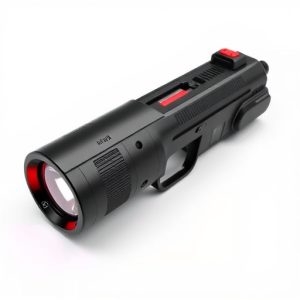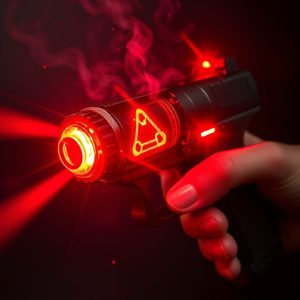Triad Stun Guns: Unveiling Detection Challenges & Emerging Solutions
With personal safety as a growing concern, detecting and identifying concealed weapons like the Tria…….
With personal safety as a growing concern, detecting and identifying concealed weapons like the Triad stun gun has become critical. These stun guns, disguised as everyday objects, pose a threat if misused. Advanced technologies such as metal detectors and specialized scanners are essential for maintaining security in public spaces and high-risk areas. The Triad Stun Gun, with its compact design and powerful shock capabilities, requires sophisticated detection methods due to its small size. Security measures need continuous improvement through advanced sensors, algorithms, and AI to keep pace with evolving concealed weapon trends, ensuring effective detection in dynamic environments like airports and crowded streets.
In an era where personal safety is a paramount concern, concealed weapon detection has become increasingly critical. This article delves into the complex world of stun gun detection, focusing on the Triad Stun Gun: its unique features and impact on current detection methods. We explore the challenges faced in identifying these hidden devices, from real-world scenarios to emerging technologies. By understanding these intricacies, we can navigate towards more effective strategies for enhanced stun gun detection.
- Understanding Concealed Stun Gun Detection: A Comprehensive Overview
- The Triad Stun Gun: Features and Its Impact on Detection Methods
- Challenges in Detecting Concealed Stun Guns: Real-World Considerations
- Emerging Technologies and Strategies for Enhanced Stun Gun Detection
Understanding Concealed Stun Gun Detection: A Comprehensive Overview
The detection and identification of concealed stun guns have become increasingly important in recent years, as personal safety and security concerns rise. With a wide range of stun devices available on the market—including popular models like the triad stun gun—it’s essential to implement effective methods for their recognition. These tools operate by delivering an electric shock, often disguised as everyday objects, making them potentially dangerous if used maliciously.
Understanding how these devices work and what they look like is the first step in enhancing security measures. Modern technology offers a range of solutions, from advanced metal detectors to specialized scanners that can detect the unique electrical signatures of stun guns. By employing such tools, public spaces, airports, and other high-risk areas can better navigate the challenges posed by concealed stun guns, ensuring the safety of individuals and maintaining a secure environment.
The Triad Stun Gun: Features and Its Impact on Detection Methods
The Triad Stun Gun stands out as a significant advancement in non-lethal self-defense technology, featuring a unique blend of power and discretion. Unlike traditional stun guns that rely on bulk for impact, the Triad model incorporates advanced design elements to reduce its profile while maintaining high voltage output. This compactness makes it easier to conceal, allowing users to carry it discreetly as a personal safety measure. The stun gun’s impact is delivered through a combination of innovative components, including specialized electrodes and a high-capacity battery, ensuring a powerful shock that can incapacitate an assailant without causing serious harm.
Its compact nature presents both a challenge and an opportunity for detection methods. While its small size makes it less conspicuous during routine security checks, it also necessitates more sophisticated scanning techniques. Advanced metal detectors and specialized imaging technologies are becoming essential tools to identify concealed Triad stun guns, as they can pierce through layers of clothing and subtle alterations in shape or density that might otherwise go unnoticed. This evolution in detection methods reflects the growing importance of addressing hidden weapons, underscoring the need for both improved security infrastructure and public awareness regarding non-lethal self-defense options like the Triad stun gun.
Challenges in Detecting Concealed Stun Guns: Real-World Considerations
Detecting concealed stun guns presents a unique challenge for security personnel and law enforcement due to their compact design and ease of concealment. Unlike traditional firearms, stun guns often lack distinct physical features that readily signal their presence—a problem further exacerbated by the diverse range of models available on the market. The triad stun gun, for instance, stands out for its innovative three-pronged design, yet it also poses a dilemma for detection methods reliant on standard shapes and sizes.
Real-world considerations further complicate matters. In dynamic scenarios like airports, concerts, or crowded streets, where metal detectors are employed, distinguishing between legitimate items and stun guns can be difficult. Additionally, the use of materials like silicone or rubber cases, which can impede magnetic fields, adds another layer of complexity. As a result, security measures must evolve to keep pace with these concealed weapons, necessitating advanced technologies and continuous training for personnel to ensure effective detection.
Emerging Technologies and Strategies for Enhanced Stun Gun Detection
Emerging technologies are playing a pivotal role in enhancing the detection capabilities for stun guns, addressing a growing concern in security and law enforcement. One innovative approach involves the use of advanced sensors and algorithms that can identify unique energy signatures emitted by stun guns when activated. These sensors, often integrated into wearable devices or stationary systems, detect subtle vibrations and electromagnetic pulses, allowing for early warnings even before the weapon is fully deployed.
Additionally, artificial intelligence (AI) is revolutionizing stun gun detection with its ability to learn and adapt. AI algorithms can analyze vast data sets of stun gun activations, improving accuracy over time. This technology, known as machine learning, enables devices to recognize patterns specific to triad stun guns, which have gained notoriety for their compact design and concealment capabilities. By continuously refining detection methods, security measures can keep pace with the evolving landscape of concealed weapons.
As we’ve explored, concealed stun gun detection presents significant challenges due to their diverse designs and users’ efforts to evade detection. While traditional methods have limitations, the rise of advanced technologies like the Triad Stun Gun offers promising solutions. This innovative device, with its unique features, pushes the boundaries of detection, urging further research and development in this critical field. By staying informed about emerging strategies, law enforcement can better navigate the evolving landscape of stun gun possession and ensure public safety.


